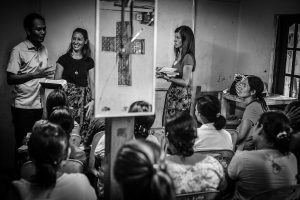As many of my readers know, I spent nearly two decades in the domestic field of conflict resolution and consensus building before seriously pursuing my interest in peace processes. One of my big areas of practice was in public policy: helping government officials work with interest groups (or “stakeholders”) and the general public on controversial environmental or development issues. My main role was usually to facilitate or mediate an in-depth dialogue or negotiation among stakeholders, and alongside this my colleagues and I also worked to inform and get input from the general public. These activities (both the stakeholder consensus building and the broader public consultation) are part of the field of practic e known as public participation (or public involvement or community engagement or other similar terms).
e known as public participation (or public involvement or community engagement or other similar terms).
In more recent years, in my study of peace processes, I focused on the question of inclusivity. One of the two prongs of my research was inclusion of civil society. Questions included whether including civil society in peace negotiations produces more durable peace (short answer: it does), and how this can be done effectively (no short answer).
Along the way, something struck me: “civil society” means more or less the same thing as “stakeholders” and possibly “the public” or “the community.” And, “inclusion” of civil society doesn’t necessarily mean having such groups represented at the peace negotiating table; it can mean that they are consulted or given opportunities to participate in a variety of ways… many of which are the same techniques I used (and saw colleagues use) in domestic public engagement.
Yet, as far as I can tell, these two fields don’t talk to each other.
I’d like to change that. They (we) could learn a lot from each other. I’ve got an article in the works (I’ll let you know when it’s published) on what the domestic public participation/community engagement field can learn from peace processes, and I’m starting with this blog post to look at what peacemakers can learn from the public participation field.
Here I’m going to present just one idea to improve civil society engagement in peace processes, and I’d like to present others in future posts.
One of the key principles of public involvement is that it “provides participants with the information they need to participate in a meaningful way.” That is, before you can ask stakeholders or the public (i.e., civil society) to make meaningful comments or contributions to a decision making process, they need to learn what the issue is all about and stay informed at each stage of the decision making process. I think peace processes do this, but I don’t know if it is always so systematic. It might be helpful, for instance, to have people on the mediation team dedicated to getting information out effectively through multiple channels that are used by the population in question. This is also an area where civil society organizations can be key–for example, women’s organizations helped inform the public of Liberia’s 2003 peace agreement and DDR process. Effectively informing the public requires a variety of communications channels that are used by the population in question: a website make more sense in one place (see for instance the website for the Philippines peace process), radio in another; print newspapers in one place; speakers at religious gatherings in another. Having frequent communication by multiple channels is key.
Peace processes are complex and controversial, and they depend for their success on public support. Keeping the public informed is just one small but critical part of effectively engaging civil society in peace processes. This in turn enables peace negotiators to fashion a peace that serves the greater good and earns the public’s support.
Leave a Reply